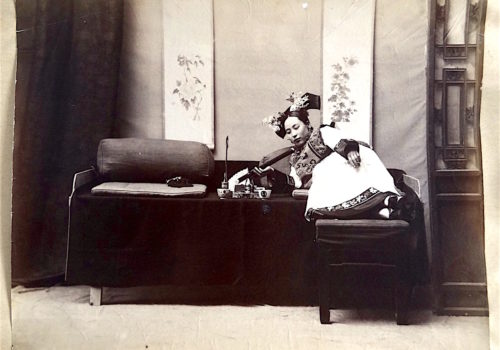«Beijing disappears, photographs taken in 1900-1903»
The photographic collection consists of one hundred and fifty vintage prints, all printed in the period 1900-1903 when they were collected by a member of the French legation in Peking.
The collector gathered prints not only of the events and their consequences but also photographs documenting everyday’s life in China in the late Qing Dinasty. Only a minority of the photographs are stamped or signed in negatives, but all are captioned in pencil in French language. The «French diplomat» probably took pictures himself, and then chose them carefully from a Chinese photographer (group A), as well as Japanese (group B), French (group C), Russian (group D) and maybe American photographers. Theprints are in majority in good condition, with some creases and defects, the tonality varies from mediocre to very strong depending of photographer’s processes. Sanshichiro Yamamoto and Y sui Tsu are both quoted by Claire Roberts, Photography and China, pages 50-51, Meynadier and Hocquart are both known to have taken pictures when present in the French legation during the Boxer rebellion.
« The Boxer Rebellion was a violent uprising which took place in China towards the end of the Qing dynasty between 1899 and 1901. It was initiated by the Militia United in Righteousness (Yihetuan), known in English as the “Boxers”, an offshoot of the Baguadao (“Way of the Eight Symbols”) folk religious network of north China, and was motivated by proto-nationalist sentiments and opposition to imperialist expansion and associated Christian missionary activity. The Great Powers intervened and defeated the Chinese forces.
The uprising took place against a background of severe drought and the disruption caused by the growth of foreign spheres of influence. After several months of growing violence against the foreign and Christian presence in Shandong and the North China plain in June 1900, Boxer fighters, convinced they were invulnerable to foreign weapons, converged on Beijing with the slogan “Support Qing government and exterminate the foreigners.” Foreigners and Chinese Christians sought refuge in the Legation Quarter. In response to reports of an armed invasion to lift the siege, the initially hesitant Empress Dowager Cixi supported the Boxers and on June 21 declared war on the foreign powers. Diplomats, foreign civilians and soldiers as well as Chinese Christians in the Legation Quarter were placed under siege by the Imperial Army of China and the Boxers for 55 days.
Chinese officialdom was split between those supporting the Boxers and those favoring conciliation, led by Prince Qing. The supreme commander of the Chinese forces, the Manchu General Ronglu (Junglu), later claimed that he acted to protect the besieged foreigners. The Eight-Nation Alliance, after being initially turned back, brought 20,000 armed troops to China, defeated the Imperial Army, and captured Beijing on August 14, 1901, lifting the siege of the Legations. Uncontrolled plunder of the Chinese capital and the surrounding countryside by foreigners ensued, along with rape, lynchings and summary executions.
The Boxer Protocol of 7 September, 1901 provided for the execution of government officials who had supported the Boxers, provisions for foreign troops to be stationed in Beijing, and 450 million taels of silver—more than the government’s annual tax revenue—to be paid as indemnity over the course of the next thirty-nine years to the eight nations involved.
The events also left a longer impact. The historian Robert Bickers found that for the British in China the Boxer rising served as the “equivalent of the Indian ‘mutiny'” and came to represent the Yellow Peril. Later events, he adds, such as the Chinese Nationalist Revolution of the 1920s and even the activities of the Red Guards of the 1960s, were perceived as being in the shadow of the Boxers.» [Cf. Wikipedia]
The photographic collection consists of one hundred and fifty vintage prints, all printed in the period 1900-1903 when they were collected by a member of the French legation in Peking.
The collector gathered prints not only of the events and their consequences but also photographs documenting everyday’s life in China in the late Qing Dinasty. Only a minority of the photographs are stamped or signed in negatives, but all are captioned in pencil in French language. The «French diplomat» probably took pictures himself, and then chose them carefully from a Chinese photographer (group A), as well as Japanese (group B), French (group C), Russian (group D) and maybe American photographers. Theprints are in majority in good condition, with some creases and defects, the tonality varies from mediocre to very strong depending of photographer’s processes. Sanshichiro Yamamoto and Y sui Tsu are both quoted by Claire Roberts, Photography and China, pages 50-51, Meynadier and Hocquart are both known to have taken pictures when present in the French legation during the Boxer rebellion.
















